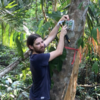As recipients of the WILDLABS AWARDS 2024, our team - formed of Open Acoustic Devices (@Andrew_Hill, @alex_rogers, @PetePrince ) and the Zoological Society of London (@Anthony_Dancer, @LydiaKatsis, @LewisRowden) - is developing AudioMoth (a low-cost acoustic recorder) for the detection of African forest elephant rumbles. This critically endangered species is often found in dense forests, making it highly challenging to monitor using traditional methods. We aim to enable wide-spread monitoring of this species by developing a low-cost, low-frequency recorder that captures the far travelling rumbles that these forest elephants produce.
The development will explore low-cost external plugin sensors, additional amplification/filtering circuitry, software to support lower sample rates and custom housings for long-term deployments. We will test hardware in the UK at ZSL’s Whipsnade Zoo, and run trials in Central Africa.
The outcome of this project is to make the low-frequency AudioMoth available to acquire. We hope making the device available will enable monitoring of a wider range of species that produce infrasonic sounds, or even to discover additional species with as-of-yet-unknown infrasonic sound vocalisation abilities.
11 April 2024 4:05pm
Awesome project!!
2 May 2024 6:24pm
Very interesting project! I had a few questions or things to consider. Funny enough, I work next to the Elephant Listening Project (ELP) in Central Africa. They've tried a few things to capture infrasonic sounds from these guys like with geophones, mics, and hydrophones, but while successful in Savannah elephant species, the dense forest and ground structure in Central Africa from my understanding increases the acoustic impedance and presented a challenge. Besides ground type, I'm also curious if there are differences in infrasonic vocalizations of Asian versus Central African elephants to consider? I think they'd be a great group to collaborate with, if you haven't reached out already!
The other question I had is if you're thinking of hardening the case? From what I've seen, elephants will break/play anything they find new. The acoustic swift team had to make a custom case for them so the elephants have a "less" likely chance of breaking them. Below is an example of a tusk versus a Pelican we keep around.

3 May 2024 4:58pm
@Andrew_Hill Amazing project and something I have been looking into as well. I do human-elephant conflict work in Asia mainly in Sri Lanka. I am using a series of Audiomoth to collect vocalizations and conflict data. It would be great to chat with you and maybe collaborate if you want to test them with Asian elephants in the field.
7 May 2024 12:26pm
Hi Adrew,
I'd love to hear more on how you detect the rumbles! We actually just started our second AI for Good Challenge on this topic together with Cornell University where we have exactly this goal of detecting rumbles in addition to gunshots and vehicle noises:
For this we have gotten access to labeled data from the Elephant Listening Project, I'm also curious if you have identified additional datasets that could help us create a more generalizable model that we can open-source.













Carly Batist